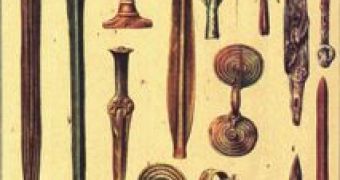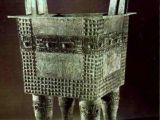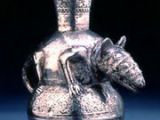The crockery was the first technological process through which people handled high temperatures and complicate chemical reactions of oxidation and reduction. 8,000 years ago, European populations were using malachite (a copper oxide) to get colorants.
Perhaps ancient people noticed the transformations suffered by this mineral in contact with the fire. At the end of the Neolithic (the last Stone Age), about 6,300 years ago, people from Indus Valley (today northwestern India-Pakistan) to Central Asia started to process the copper.From these regions, copper processing spread to western Asia and Europe.
Archaeologists found that in North America the process started even earlier: 8,000 years ago. The copper was processed at the beginning in cold form, as it is soft, but later also heated. After that, people found how to reduce copper ore at 700-800o C, and also melting it and founding it at 1085o C.
The people of the Middle East, at the end of the Neolithic, 6,000 years ago, knew the metallurgy of the copper and bronze. The bronze civilization spread rapidly through migration and trade even 5,000 years ago.
The heated copper is ductile like clay and liquefied takes the shape of the mold in which is founded.
Practically, if a copper ax or hammer are not harder than silex tools, they possess the advantage of being resharpened or remolded. To achieve copper tall furnaces with air circulation were built, and these were able to reach high temperatures.
The bellows appeared in Egypt 3,500 years ago and in Europe 3,000 years ago.
In Crete, bronze was produced about 4,000-3,000 years ago.
In China, one of the best bronzes appeared during the Shang dynasty (1766-1050 BC), while in the Bolivian-Peruvian Andes were discovered five thousand tall furnaces producing bronze beginning with 3,000 years ago.
But the oldest bronze discovered till now was found in 6,000 years old archaeological sites in Thailand (Ben Chang plateau). It looks like bronze emerged independently in Eastern Asia and the Middle East.
People preferred the bronze when they realized that the alloy of copper with lead or tin was easier to mold and it turned harder.
The chemical formula varied even inside the same production center, thus they were looking for the best metal.
4,000 years ago the best formula for the bronze was found: 90 % copper and 10 % tin.
From stone molds people passed to wax forms for founding bronze.
The model of the object to be founded was made of wax (in the case of larger objects, the core was made of clay).
This was covered with a layer of fine clay or lime.
After drying, in this layer holes for aerating and founding channels were made.
After heating, when the wax melted, it was replaced by liquid bronze.
When the bronze solidified, the covering clay was broken, and the object did not bear any sign of founding. The object was finished by using files, hammers, abrasive materials and others.
This technique was present in Egypt and Mesopotamia 5,000 years ago and 4,000 years ago also in Crete. By 3,200 years ago, the Bronze Age ended in the Old World, the bronze role being taken by iron.

 14 DAY TRIAL //
14 DAY TRIAL // 

